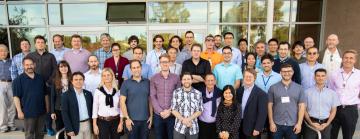Proposals
Proposals submitted to FACET-II are peer reviewed. The highest rated proposals are offered beam time based on availability and the scope of infrastructure changes required to support the experiment. We recommend that you check the beam parameters and infrastructure available at FACET-II as you consider your proposal.
FACILITY CONTACTS
Mark Hogan
Facility Director
(650) 926-2951
hogan@slac.stanford.edu
------------------------------------------
Carsten Hast
Test Facilities Manager
(650) 926-8556
hast@slac.stanford.edu
------------------------------------------
Amy Ecclesine
Safety Officer
(650) 926-8553
amyecc@slac.stanford.edu
We are currently only calling for new proposals for FACET-II.
- Proposals are accepted any time of the year and will be reviewed at the next available program advisory committee meeting
- To submit a proposal, please use our Template, and see our Proposal Review Process
- Proposals should be approximately two-five pages long and use the provided Template
- To submit a proposal, follow up or ask questions about the process, please email Mark Hogan
To Submit a Proposal to FACET-II
- Proposals should be approximately two-five pages long and use the provided template
See our proposal review process
Staying in Touch
You can sign up for our mailing list to receive calls for proposals and announcements of meetings. To subscribe, send an email to listserv@slac.stanford.edu. The subject doesn't matter, but the text should say subscribe facet-interest.
FACET-II was commissioned 2020 - 2021. The first full year of User programs with 10 GeV compressed electron beams is began in the fall of 2021 and ran until August 2022.
| Electron Beam | |
|---|---|
| Beam Type | e- |
| Beam energy (GeV) | 10 |
| Repetition Rate (Hz) (range) | 10 1-30 |
| Bunch Charge (nC) (range) | 2 0.5-3 |
| Bunch Length (σ, µm) (range) | 20 1-100 |
| Beam Spot size (σ, µm) (range) | 30 5-200 |
| Experimental Laser | |
| Pulse Energy on target at electron beam line (mJ) (range) | 250 (10-350) |
| Pulse Duration full width at half maximum (fs) (range) | 50 (50-600) |
Facility staff can work with users to develop beam configurations that match their needs.
Three configurations are currently planned, designed to serve the priority experiments at FACET-II.
1. Single Bunch, high Ipk: Ipk 50-300kA , β* x,y=0.1-1m
2. 2-bunch: 1.5/0.5 nC, 30/15 | 20/10 kA, dz=150 μm, β* x,y=5-50cm
3. Single Bunch, high E, low δE, low aberrations: E=13GeV, σz=100μm, β* x,y=10m
A presentation at the 2019 Science Workshop provides more information.
The first configuration (single bunch, high I peak) will be developed in the fall of 2021 for experiment time in 2022. The second configuration (2-bunch) will be developed subsequently for experiment time later in 2022.
FACET-II was designed to meet the Department of Energy Mission Need Statement for an Advanced Plasma Acceleration Facility. A key component of the experimental program at FACET-II, and approximately half of the beam time, is allocated to research in plasma wakefield acceleration. Topics include high-gradient electron acceleration with narrow energy spread and preserved emittance, efficiency, high-gradient positron acceleration and radiation generation. This program of FACET-II research is directed at understanding and establishing plasma wakefield acceleration as a viable particle acceleration technique. Researchers interested in plasma wakefield acceleration are encouraged to propose a multi-year program addressing the critical issues for this technology.
We specifically encourage the formation of a broad plasma wakefield collaboration to develop both individual research proposals and an overall strategic plan for demonstrating an understanding of this approach as a particle acceleration technique. Plasma experiments should still be proposed through the route outlined above with each experiment studying a distinct aspect. Though collaboration is naturally encouraged to share resources and expertise, we strongly welcome groups that have not yet been a part of the program at FACET-II.
To propose new experiments for our plasma program and to join our efforts to generate a coordinated approach to developing this technique, please contact Mark Hogan, our Scientific Lead at FACET-II.

